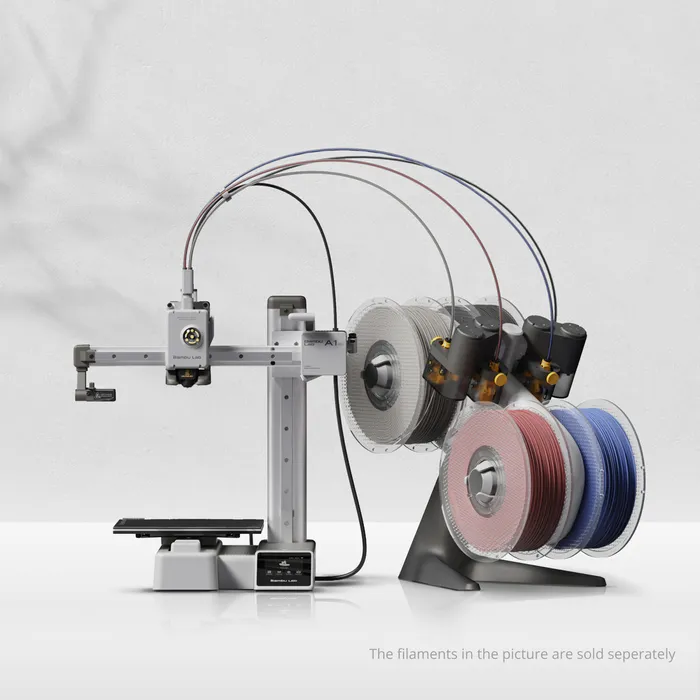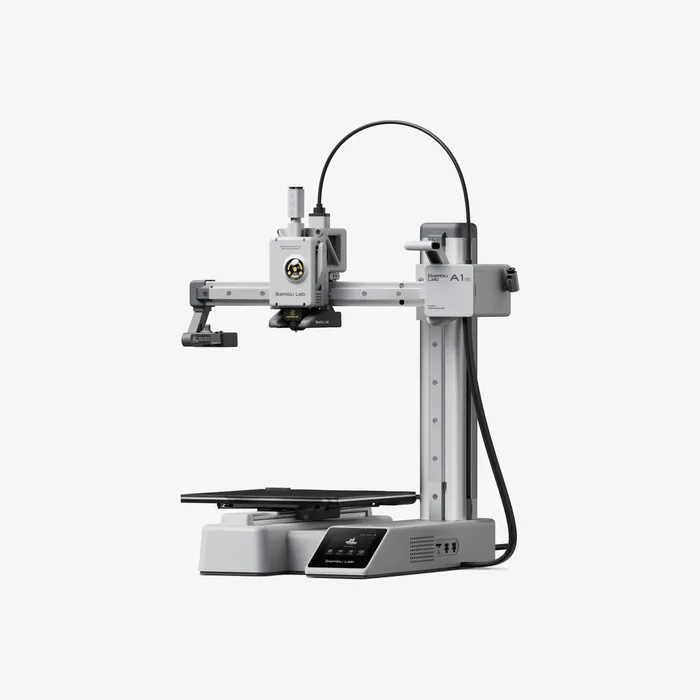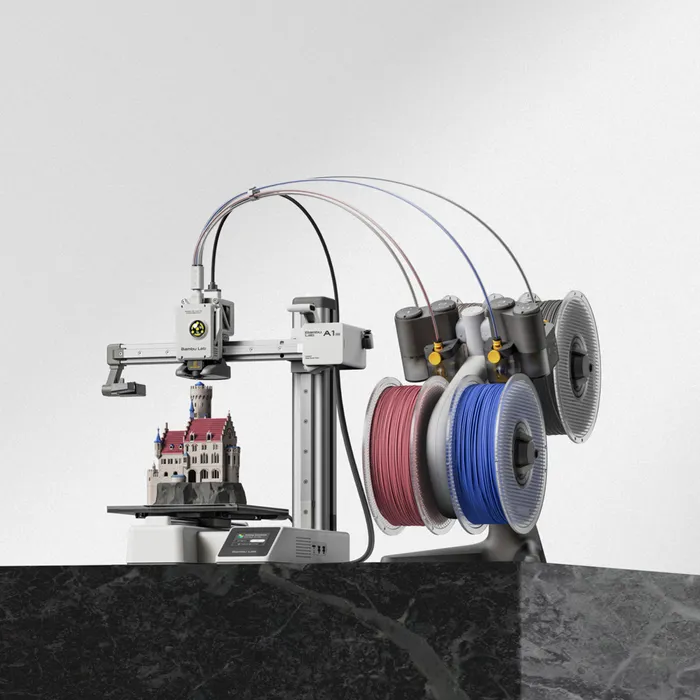Well, well, well, if it’s not another day, another revolution in the 3D printing world, courtesy of Bambu Lab. Just when you thought they’d settled into a rhythm with their high-speed CoreXY machines, they pull a fast one and drop the Bambu Lab A1 Mini 3D printer on us. And let me tell you, this little marvel, especially when bundled with its ingenious AMS Lite, isn’t just another printer; it’s a meticulously crafted gateway drug to the vibrant, multi-coloured world of 3D printing, designed to tempt even the most hesitant beginner into our additive manufacturing addiction.

Now, if you’re a seasoned maker like myself, you might have initially scratched your head. A bed slinger? From Bambu Lab, the masters of enclosed, lightning-fast CoreXY printers like the X1 Carbon and P1S? But hold your horses, because the A1 Mini isn’t aiming for the pros, not primarily anyway. This machine, particularly the Bambu Lab A1 Mini Combo with the AMS Lite, is Bambu Lab’s audacious play for the mainstream, a direct challenge to anyone who thought 3D printing was too complicated, too expensive, or just too… well, beige.
Think of it this way: Bambu Lab is doing for 3D printing what Cricut did for crafting machines, or what DJI did for consumer drones. They’re making it accessible, intuitive, and, dare I say, fun for everyone. Yes, everyone – even your technophobic aunt who still struggles with her smart TV remote. And at just $299 for the standalone printer and a jaw-dropping $459 for the combo package (including the AMS Lite), it’s priced to steal the hearts and wallets of budding creators everywhere. This isn’t just budget-friendly; it’s practically a steal for the features on offer.
Unboxing Joy and Setup Simplicity: Get Printing, Pronto!
One of the most delightful aspects of the Bambu Lab A1 Mini is its sheer ease of setup. Forget spending hours poring over cryptic manuals and wrestling with tiny screws. This printer arrives about 95% pre-assembled. My unboxing experience was less about assembly and more about unwrapping a gift. You’re looking at a mere 15-20 minutes from box to first print, even with the AMS Lite!
What does this “assembly” entail, you ask? A few zip ties, a guard around the print head, and a couple of screws for the filament wiper and spool holder. If you opt for the AMS Lite combo, that snaps together quickly too, securing onto its neat little stand. The instructions are crystal clear, each part thoughtfully labelled, practically making it impossible to mess up.

And once it’s out and about? The Bambu Lab A1 Mini boasts full auto-levelling. Yes, you read that right. The nozzle itself acts as the probe, setting the Z-height perfectly every time. No more finicky paper tests or endless manual adjustments. It just works. This “hands-off” approach is a massive win for beginners, removing one of the most common hurdles to successful 3D printing.
Design with a Purpose: Compact, Clever, and Surprisingly Quiet
The A1 Mini sports a modern, almost “IKEA-esque” aesthetic with its cantilever design. On its own, it’s remarkably compact, taking up roughly the same space as an A4 sheet of paper. This means it can comfortably sit on a desk or workbench without devouring your entire workspace.
Under the hood, or rather, out in the open, there’s a direct-drive extruder with a full metal hotend capable of reaching 300 degrees Celsius. This means it handles common filaments like PLA, PETG, and TPU with aplomb. However, due to its open-air design (which is fantastic for accessibility and maintenance), Bambu Lab doesn’t recommend abrasive or fiber-filled filaments, or those prone to warping like ABS, ASA, or PC, without an enclosure. Something to bear in mind if you’re planning on venturing into more exotic materials.
One of the standout features is the quick-swap nozzle system. Unlike other printers where a nozzle change can be a messy, fiddly affair involving wires and thermal paste, the A1 Mini’s nozzles are held in place by a strong magnet and a simple metal buckle. No screws, no fuss – just unclip, swap, and clip. It’s genius design for easy maintenance.
The toolhead itself is surprisingly slimmed down. It features a clever filament cutter and a little tray that collects purged filament during color changes, humorously flinging it to the side. While this might sound messy, it’s actually a vast improvement over the internal chutes of larger Bambu machines that can easily clog. A small open box beside the printer easily collects the “poop.”
For monitoring, there’s an onboard camera (with a manual privacy shutter, thank goodness!) that’s great for remote observation and time-lapses. While it doesn’t have AI print-fail detection (a feature found on its pricier siblings), it does provide helpful error codes linked to Bambu Lab’s comprehensive Wiki, often with video tutorials to guide you through troubleshooting. This level of self-help and clear guidance truly empowers new users.
But here’s the kicker that surprised even me: this printer is whisper quiet. Bambu Lab has implemented advanced noise cancellation technology that actively mutes motor vibrations. During its initial power-up, it goes through a noise cancellation procedure, and the result is a printer so quiet, you could comfortably have it running in a shared living space or even a child’s bedroom without disturbance. This is a game-changer for home users.
The AMS Lite: A Splash of Colour for Everyone
The real star of the Bambu Lab A1 Mini Combo is the AMS (Automatic Material System) Lite. While its external, almost “bowden tube spaghetti monster” aesthetic might seem a bit busy compared to the sleek, enclosed AMS of the X1 Carbon, it’s a triumph of practicality and affordability.
The beauty of the AMS Lite lies in its simplicity and reliability. Each of its four spools sits on a spring-loaded, motorized spindle. This design eliminates many of the jamming issues seen with the original AMS, which struggled with certain spool types (like cardboard or unusually wide/light spools). Now, almost any filament spool can be used without a hitch. And since each color has its own dedicated PTFE tube running to the print head, filament changes are significantly faster than on other multi-material systems, as the filament only needs to retract a few inches. This is a massive win for multi-colour print times, making them much more palatable. Indeed, some comparative tests show the A1 Mini printing multi-colour models faster than its CoreXY siblings due to these rapid swaps.
Of course, multi-color printing does come with a caveat: filament waste. Each color change requires purging the old filament from the nozzle. While Bambu Studio allows for tuning to reduce this waste, it’s still a factor to consider. The software will even tell you exactly how much filament will be purged before you start a print, so you’re never caught off guard.
Software Savvy: Bambu Studio and MakerWorld
To get your designs onto the A1 Mini, you’ll primarily use Bambu Studio, Bambu Lab’s custom slicer (a fork of PrusaSlicer). It’s powerful yet user-friendly, offering both beginner-friendly presets and advanced controls for those who want to fine-tune every aspect of their prints. Importantly, Bambu printers use 3MF files, so you’ll need to use Bambu Studio or the open-source OrcaSlicer to prepare your models. Connectivity is seamless via Wi-Fi (2.4GHz only), or you can go old-school with a microSD card.
Bambu Studio also acts as your digital “paint palette” for assigning colours to your models when using the AMS Lite. The device tab provides direct control over the printer, allowing you to manage filaments, heat the bed and nozzle, and monitor print progress.
A game-changer released alongside the A1 Mini is MakerWorld. This is Bambu Lab’s answer to popular 3D model repositories, but with a crucial twist: cloud slicing. You can browse models directly from the MakerWorld website or the Bambu Handy mobile app and send them straight to your printer. The slicing happens automatically in the cloud, using pre-defined parameters by the designer or other community members, tailored to your printer and filament types. This streamlines the entire process, making “download, slice, print” a thing of the past for casual users.
Performance: Speedy Prints, Stellar Quality
Despite being a bed-slinger (a design often considered slower than CoreXY), the Bambu Lab A1 Mini is shockingly fast. With a top speed of 500mm/s and default slicer speeds in the 200-300mm/s range, it’s genuinely one of the fastest Cartesian printers I’ve encountered. Its excellent input shaping effectively tames vibrations, resulting in smooth, high-quality prints without the dreaded “ringing” or layer shifts.
I ran a standard 3D Benchy torture test, and the A1 Mini churned it out in an astonishing 19 minutes and 15 seconds (using “Speed Boat Rules” settings). While there was some minor sloppiness on overhangs due to rapid cooling, the overall print quality was exceptional for such a speed demon. For context, a typical printer might take 45 minutes or more for the same print.
For more complex, multi-colour prints, the A1 Mini truly shines. A multi-coloured articulated Forest Wish Spirit, sliced with default settings, printed beautifully smooth with no visible layer lines. Even a PETG test print of “Mini Joel” was clean and crisp, finishing in a mere 1 hour and 16 minutes – a job that would take a traditional printer around 3 hours. And for flexible TPU, though the AMS doesn’t support it (you use the single spool holder), the A1 Mini handled it with surprising finesse, producing a clean rubber duck with minimal stringing.

The Verdict: A Mini Masterpiece for the Masses
The Bambu Lab A1 Mini 3D printer is, without a doubt, a phenomenal piece of engineering. It’s fast, quiet, incredibly easy to use, and offers accessible multi-colour printing thanks to the innovative AMS Lite. While its smaller build volume (180 x 180 x 180 mm) might be a limitation for some larger projects, for the vast majority of everyday prints and fun models, it’s perfectly adequate.
The cons are minor: the AMS Lite takes up a bit of space (though its practicality outweighs this), and multi-color printing does generate waste (a common issue across all multi-material systems). The small touchscreen might require a stylus for some, but these are hardly deal-breakers.
For beginners looking to dive into the world of 3D printing, especially those eager to experiment with multiple colours, the A1 Mini is a no-brainer. Its out-of-the-box experience is unparalleled, making the learning curve feel more like a gentle slope. At $459 for the combo, it offers incredible value and a level of sophistication previously reserved for much pricier machines.
Even for seasoned enthusiasts, the A1 Mini holds significant appeal. Its sheer speed, quiet operation, and refined user experience make it a compelling addition to any workshop, especially if you’re looking for a reliable, fuss-free printer for smaller, colourful projects. When compared to similarly priced alternatives like the Prusa Mini or even self-built Voron kits, the A1 Mini often outpaces them in performance and certainly in ease of use, straight out of the box, offering multi-colour capabilities where others only offer one.
So, unless you absolutely need a massive build volume or an enclosed chamber for finicky high-temp filaments, I wholeheartedly recommend the Bambu Lab A1 Mini. It’s a clear step towards making advanced 3D printing truly accessible to everyone, and that, my friends, is something worth celebrating.
Key Takeaways for Your Search:
- Bambu Lab A1 Mini Review: This printer excels in ease of use, speed, and multi-color capability.
- Best 3D Printer for Beginners: Its intuitive setup and software make it ideal.
- Multicolor 3D Printer: The optional AMS Lite is a game-changer for affordable multi-filament printing.
- Budget 3D Printer: Exceptional value for money, especially with the combo.
- High-Speed 3D Printer: Don’t let its size fool you; it’s remarkably fast.
Further Reading and Resources:
- Official Bambu Lab A1 Mini Product Page: https://store.bambulab.com/products/a1-mini
- Bambu Lab Wiki (for troubleshooting and guides): https://wiki.bambulab.com/en/home
- See how the A1 Mini stacks up against other top printers:
